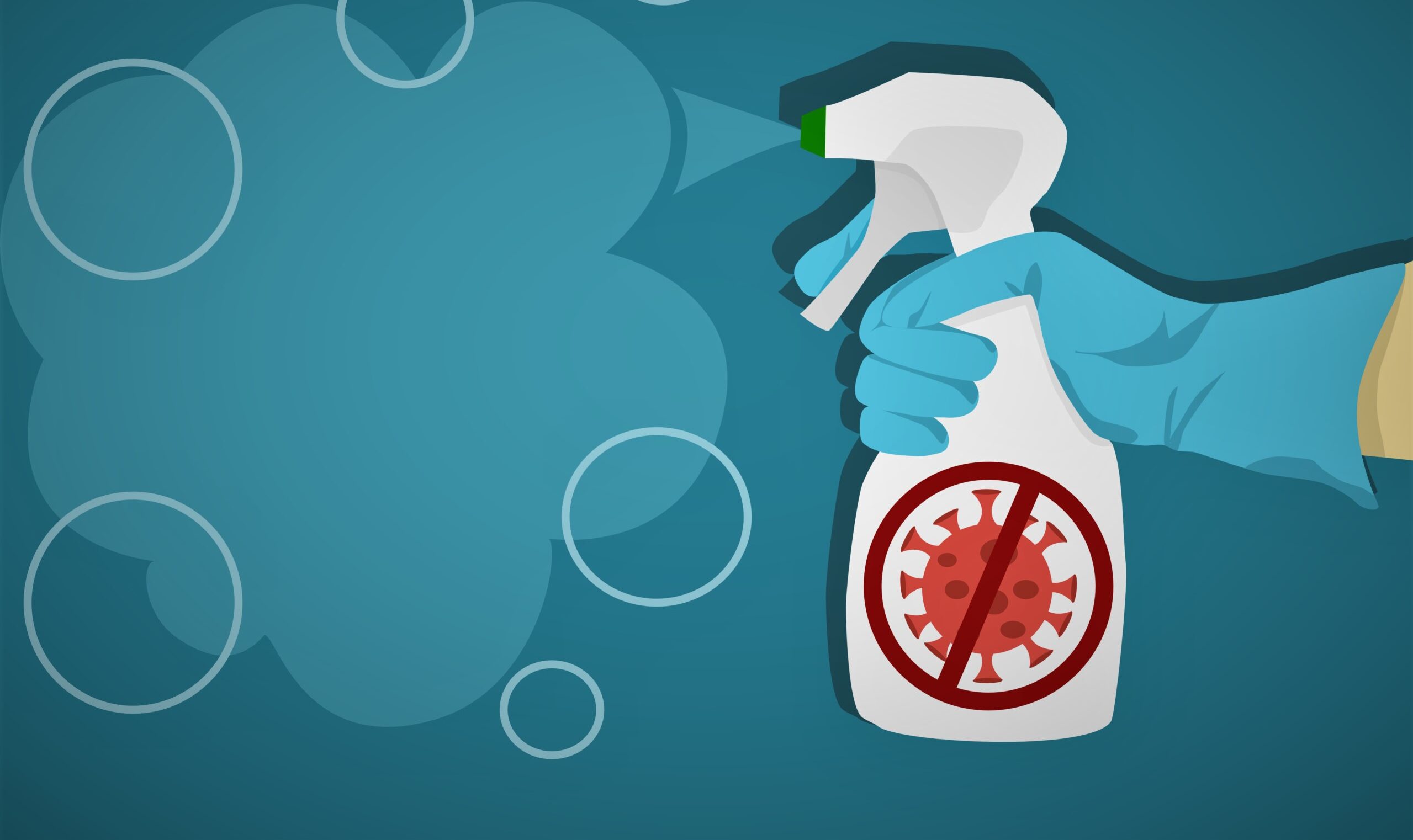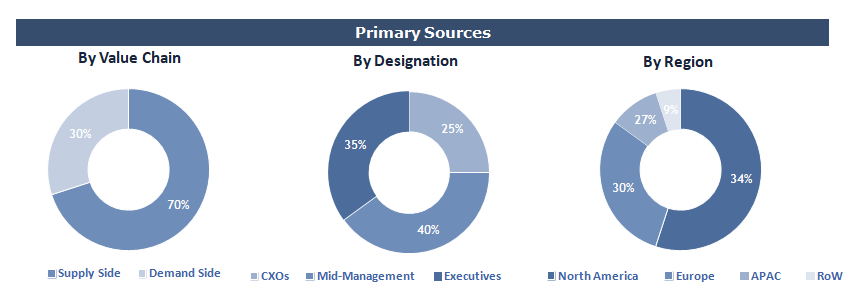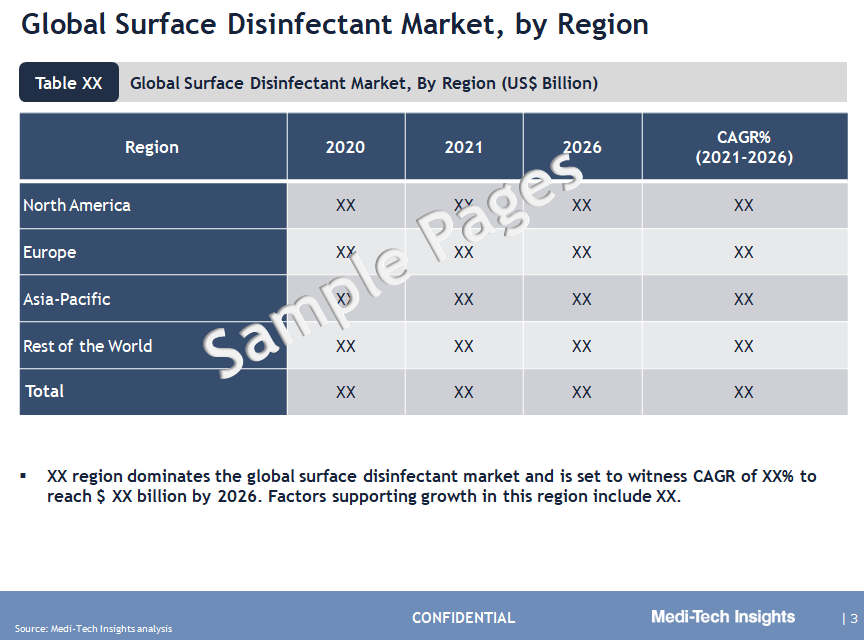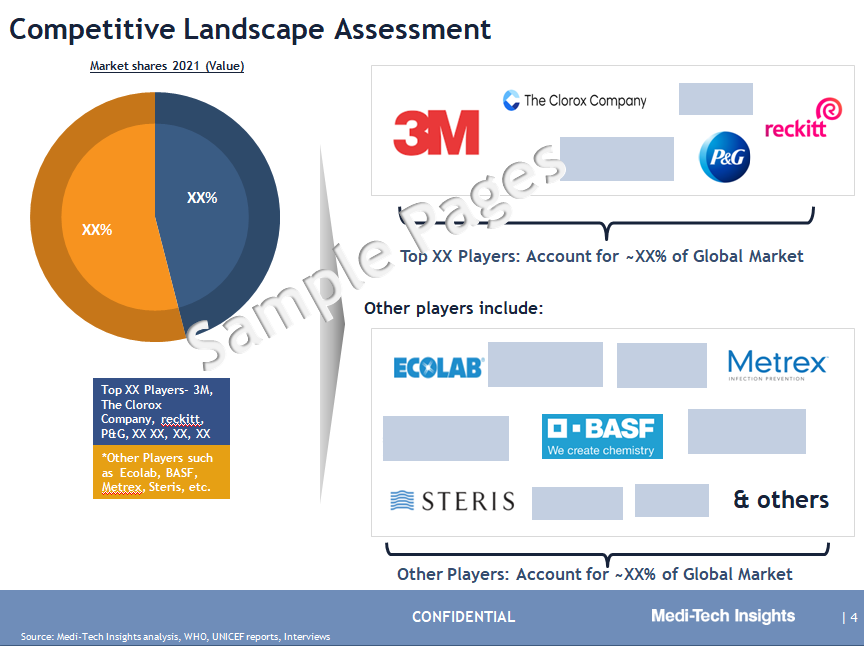
Surface Disinfectant Market Size, Shares, Growth, Trends and Demand Analysis 2026

The global Surface Disinfectant Market is expected to grow at a rate of 7.5% to reach $5 billion by 2026. Increased use of surface disinfectants in public facilities, hospitals, nursing homes, wastewater treatment facilities, and households to curb the spread of Covid-19 virus, rising demand for eco-friendly & superior-quality surface disinfectant products, increasing prevalence of hospital-acquired infections, increasing awareness regarding personal hygiene & sanitization, and the growing implementation of stringent regulations in medical hygiene for the use of surface disinfectants are some of the key factors driving the surface disinfectant market growth.
Surface disinfectants are chemical agents applied to non-living objects to destroy bacteria, viruses, fungi, mold, and mildews living on the objects. Disinfectants can be found in various chemical compounds and work in various pathways to kill pathogens, usually by destroying or damaging the cell wall of microbes or by interfering with their metabolism. Surface disinfectants can also be incorporated in different forms, such as liquids, wipes, and sprays.
Several broad categories of disinfectants are used in commercial and industrial facility maintenance to prevent the transmission of microbial infections or cross-contamination. The most common types of disinfectants are hydrogen peroxide, quaternary ammonium compounds (Quats), chlorine compounds, alcohols, aldehydes, iodophors, and phenolic compounds.
Shift Towards Bio-based Surface Disinfectants
Bio-based surface disinfectants are cleaning products that claim to kill 99.99% of bacteria and viruses on surfaces within 30 seconds to 1 minute of contact time. In bio-based cleaning products, manufacturer replaces fossil-based ingredients with bio-based ingredients such as plant oil or enzymes. Plant oil can be used to produce surfactants and enzymes work as a catalyst to improve cleaning results. Bio-based cleaning products are more environmentally friendly, as it uses natural ingredients compositions without compromising the quality of disinfectants. This shift in the trend toward bio-based products from chemical-based products is expected to drive the surface disinfectants market.
Surface Disinfectant Usage for Infection Prevention Drives the Surface Disinfectant Market
Currently, almost every environment on earth contains bacteria and microorganisms. Most bacteria are harmless to humans while other disease-causing organisms called pathogens can be dangerous to the human body. The outbreak of COVID-19 caused by the SARS-CoV-2 virus is the most contagious and dangerous disease in recent history. However, using the right type of surface disinfectant routinely for cleaning the facility is critical in preventing the spread of infections and diseases like COVID, influenza, common cold & cough, and others and also ensures quality patient care, employee protection, and proper hygiene maintenance. The surface disinfectant market is marked by the increasing launch of newer surface disinfectants that are used for infection prevention and sanitization.
For Instance,
- In June 2021, Metrex Research, LLC launched new surface disinfectant wipes under the brand name CaviWipe 2.0. These multi-purpose disinfectant wipes protect against 42 types of pathogens, including SARS-CoV-2 virus.
- In February 2021, Proctor & Gamble launched a new antibacterial home sanitizing product under the brand name Microban 24. Microban 24 is available in three different forms including a multi-purpose cleaner, bathroom cleaner, and sanitizing spray. The product is sold online and through major retailers across the globe.
- In February 2021, 3M Company launched the 3M™ Clean & Protect Certified Badge Program, a new comprehensive system for cleaning, monitoring, and protecting facilities.
“Growing usage of advanced technologies will drive the market. For instance, modern technologies such as ultraviolet light devices and no-touch room decontamination methods have been very effective in reducing bacterial contamination on surfaces.” - Chief Researcher, Leading Surface Disinfectant Manufacturer, United States
Key Challenges/ Constraints: Surface Disinfectant Market
Some of the chemical disinfectants currently available on the market are irritating to the skin, eyes, and respiratory system. If proper guidelines are not followed on the usage of these disinfectants, it can lead to serious adverse reactions. Spray products that are currently used for cleaning purposes also release chemicals such as gases and aerosols, which contain non-volatile chemicals that can cause respiratory problems if not used in properly ventilated areas. Therefore, the risks associated with the usage of surface disinfectants are likely to hamper the growth of the market.
North America: The Largest Surface Disinfectant Market
North America is the largest surface disinfectant market, followed by Europe and APAC. The large share of North America can be attributed to stringent regulations & guidelines imposed by the government on the use of surface disinfectants, rising prevalence of hospital-acquired infections, increasing awareness regarding cleanliness & hygiene products, and an increased focus on public sanitization in the region. APAC is expected to witness strong growth in the coming years, due to the active involvement of the government in controlling the spread of COVID-19, rising number of surgeries, growing prevalence of hospital-acquired infections, increasing awareness regarding the importance of personal hygiene and cleanliness, and proliferation of health & fitness clubs and gyms.
Competitive Landscape Analysis: Surface Disinfectant Market
Some of the key players operating in the market include Procter & Gamble, 3M Company, Ecolab, Reckitt Benckiser Group PLC, The Clorox Company, Cantel Medical Corporation, SC Johnson and Son Company, Pal International Ltd., Steris Corporation, Carrollclean, Metrex Research LLC, Whiteley Corporation, GOJO Industries Inc., Diversey Holdings Ltd., Tristel Plc, BASF SE, Paul Hartmann AG, Evonik Industries AG, Kimberly Clark Corporation (KCWW), Medline Industries Inc., Pharmax Pharmaceuticals FZ-LLC, PDI Inc., Becto Inc., GESCO Healthcare Pvt. Ltd., MEDALKAN, Micro-Scientific LLC, Brulin Holding Company Inc., W.M. Barr, Spartan Chemical Company Inc., Carenowmedical, and BODE Chemie, among others.
Companies Adopting Inorganic Growth Strategies to Increase their Market Share
Players operating in this market are adopting organic and inorganic growth strategies such as collaborations, acquisitions, and new product launches to garner market share. For instance,
- In February 2022, Reckitt Benckiser Group plc (“Reckitt") announced distribution collaboration with Diversey Holdings, Ltd. The collaboration will expand the distribution of Reckitt’s hygiene solutions into emerging markets, focusing on B2B channels.
- In March 2021, BASF announced it has signed two distinct partnership agreements with Allied Carbon Solutions Co., Ltd (ACS) & Holiferm Ltd to expand its global leading position in the bio-based surfactants and actives market. The strategic alliance with ACS includes an equity stake and makes BASF the single largest shareholder.
The global surface disinfectant market is a growing market that is expected to gain further momentum in the coming years due to technological advancements, stringent government regulations, new product launches, raising awareness of sanitization and hygiene due to the spread of COVID-19, and aggressive organic and inorganic growth strategies followed by the players.
Key Strategic Questions Addressed
- What is the market size & forecast of the Surface Disinfectant market?
- What are the historical, present, and forecasted market shares and growth rates of various segments and sub-segments of the Surface Disinfectant market?
- How has Covid-19 impacted the Surface Disinfectant market?
- What are the major growth drivers, restraints/challenges impacting the market?
- What are the opportunities prevailing in the Surface Disinfectant market?
- How is the investment landscape of Surface Disinfectant Market?
- Which region has the highest share in the global market? Which region is expected to witness the highest growth rate in the next 5 years?
- Who are the major players operating in the market? What is the competitive positioning of key players?
- Who are the new players entering the Surface Disinfectant market?
- What are the key strategies adopted by players?
The study has been compiled based on the extensive primary and secondary research.
Secondary Research (Indicative List)

Primary Research
To validate research findings (market size & forecasts, market segmentation, market dynamics, competitive landscape, key industry trends, etc.), extensive primary interviews were conducted with both supply and demand side stakeholders.
Supply Side Stakeholders:
- Senior Management Level: CEOs, Presidents, Vice-Presidents, Directors, Chief Technology Officers, Chief Commercial Officers
- Mid-Management Level: Product Managers, Sales Managers, Brand Managers, R&D Managers, Business Development Managers, Consultants
Demand Side Stakeholders:
- Stakeholders in Hospitals & Clinics, Surgery Centers, Diagnostics Laboratories, Ambulatory Surgical Centers, Pharmaceuticals & Biotechnology Companies, Academic & Research Institutes, Research laboratories, and Other End Users.
Breakdown of Primary Interviews

Market Size Estimation
Both ‘Top-Down and Bottom-Up Approaches’ were used to derive market size estimates and forecasts.
Data Triangulation
Research findings derived through secondary sources & internal analysis was validated with Primary Interviews, Internal Knowledge Repository and Company’s Sales Data.



